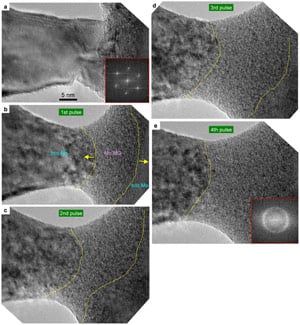
a, TEM image of two contacting Mo nano-tips with a well-defined bcc structure viewed along the left fence111right fence zone axis (inset in a). b, Formation of Mo MG under the first vitrification pulse. The GCIs are indicated by yellow dotted curves. c–e, Growth of the Mo MG under subsequent vitrification pulses. The GCIs moved one step away from each other (denoted by two yellow arrows in b) after the second (c), third (d) and fourth (e) pulse, respectively, resulting in the growth of the Mo MG. The amorphous structure is corroborated by the diffuse halos in the fast Fourier transformation (inset in e). Credit: Li Zhong, et al. Nature (2014) doi:10.1038/nature13617
In a newly published study, University of Pittsburgh researchers report an experimental approach to the formation of monatomic metallic glasses through ultrafast liquid quenching.
Materials scientists have long sought to form glass from pure, monoatomic metals. Scott X. Mao and colleagues did it.
Their paper, “Formation of Monoatomic Metallic Glasses Through Ultrafast Liquid Quenching,” was recently published online in Nature, a leading science journal.
Mao, William, Kepler Whiteford Professor of Mechanical Engineering and Materials Science at the University of Pittsburgh, says, “This is a fundamental issue explored by people in this field for a long time, but nobody could solve the problem. People believed that it could be done, and now we’re able to show that it is possible.”
Metallic glasses are unique in that their structure is not crystalline (as it is in most metals), but rather is disordered, with the atoms randomly arranged. They are sought for various commercial applications because they are very strong and are easily processed.
Mao’s novel method of creating metallic glass involved developing and implementing a new technique (a cooling nano-device under in-situ transmission electron microscope) that enabled him and his colleagues to achieve an unprecedentedly high cooling rate that allowed for the transformation of liquefied elemental metals tantalum and vanadium into glass.
Reference: “Formation of Monoatomic Metallic Glasses Through Ultrafast Liquid Quenching” by Li Zhong, Jiangwei Wang, Hongwei Sheng, Ze Zhang and Scott X. Mao, 6 August 2014, Nature.
DOI: 10.1038/nature13617

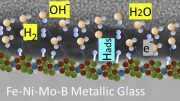
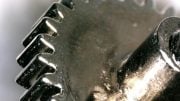
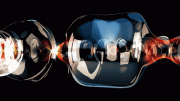
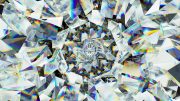
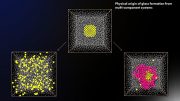
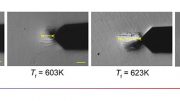

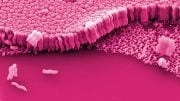
Be the first to comment on "Materials Scientists Turn Metal Into Glass"